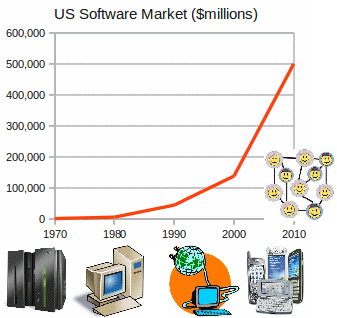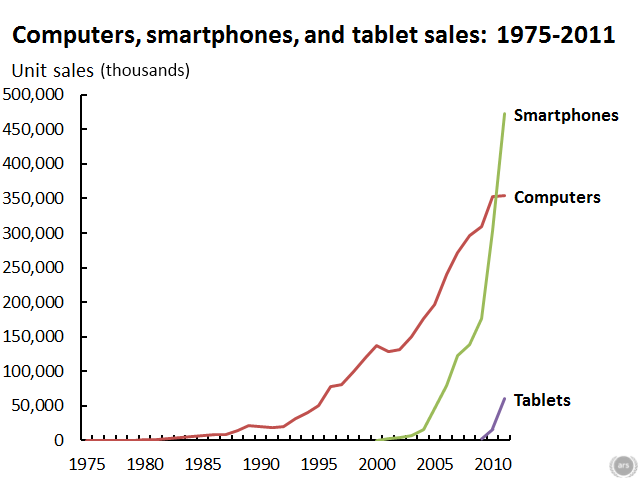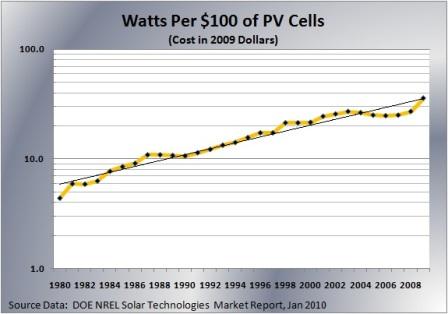Many people are unfamiliar with Moore’s Law, and how it affects solar power. Moore’s Law doesn’t occur in many technologies or industries, but it’s there in solar photovoltaic (PV). For those of us whose whole working lives have been affected by Moore’s Law, seeing it turn up in another field is like a flashing neon sign pointing to the future. A future of distributed solar power sunrise over the crumbling industrial relics of coal, nuclear, and natural gas plants. A future with much less control by monopoly utilities, which is why they fight it. If they even see it coming; Bill Gates didn’t, back in the day, but Jeff Bezos of Amazon did. They both surfed that tide, and Moore’s Law made both of them among the richest humans on the planet while changing the world for all of us. Steve Jobs even used it to put a computer in your pocket more powerful than big companies could buy a few decades ago. What does Moore’s Law for solar power mean for electric power?
This chart shows the telltale symptom of Moore’s Law in solar electricity: 65% compound annual growth rate in solar power plants deployed for the past 5 years:
Source: Solar Power Graphs to Make You Smile by Zachary Shahan for CleanTechnica 10 June 2011.
As SunPower’s Dinwoodie puts it:That 17 GW installed in 2010 is the equivalent of 17 nuclear power plants — manufactured, shipped and installed in one year. It can take decades just to install a nuclear plant. Think about that. I heard Bill Gates recently call solar “cute.” Well, that’s 17 GW of “cute” adding up at an astonishing pace.
 Bill Gates should recall that Moore’s Law made formerly “cute” PCs with his
“cute” operating system Windows expand into every company in the world
and made him the second richest human on the planet.
Growth of computer software markets,
like for the U.S. as shown in the graph on the right,
is a symptom of the original Moore’s Law.
Software runs on hardware, and these hardware market curves
are driven more directly by Moore’s Law:
Bill Gates should recall that Moore’s Law made formerly “cute” PCs with his
“cute” operating system Windows expand into every company in the world
and made him the second richest human on the planet.
Growth of computer software markets,
like for the U.S. as shown in the graph on the right,
is a symptom of the original Moore’s Law.
Software runs on hardware, and these hardware market curves
are driven more directly by Moore’s Law:
Source:
From Altair to iPad: 35 years of personal computer market share,
by Jeremy Reimer for Ars Technica, 14 August 2012.
Moore’s Law underlies all three of those hardware curves.
So what is Moore’s Law? Gordon Moore, co-founder of Intel, in a 1965 paper, noted that the number of components in integrated circuits had doubled each year from 1958 through 1965; he thought that might continue for at least another ten years. In 2005 Moore looked at it again, and said the rate in later years was actually doubling about every two years. Moore’s Law has continued like that for 40 years, as shown on this graph:
Source:
Transistor Count and Moore’s Law by
Wgsimon
in Wikimedia Commons 13 May 2011,
Creative Commons
Attribution-Share Alike 3.0 Unported license.
That may not look very fast, because it’s a straight line. But look at that Transistor count left axis: it goes from 10,000 to 100,000 to a million, and onwards to a billion, in a logarithmic scale. That’s 10,000 around 1978 to a billion by about 2008, an increase of 100,000 times. That’s the difference between big computers for a few big companies back then and a computer in your pocket now more powerful than anything NASA could buy in 1978.
What’s the equivalent for solar PV? Well, solar panels don’t get much smaller, because they still need the same amount of surface area to collect the same amount of sunlight. But they do get cheaper. So the equivalent is the plummeting cost of solar electricity, as shown in this graph of how many Watts you can get for $100 of solar cells:
Source:
Smaller, cheaper, faster: Does Moore’s law apply to solar cells?
by Ramez Naam in Scientific American 16 March 2011.
That graph doesn’t grow at exactly the same rate in Watts per $100 as the original Moore’s Law did in components per area. That doesn’t matter. What matters is that it’s a straight line on a log scale: continued exponential growth over years. You don’t find that in most markets, not in housing, or automobiles, or sports. You do find it in computer components and in solar PV.
More to follow on some implications of Moore’s Law in solar electricity. The brief version: solar will win, and not even Georgia Power or Southern Company can stop it, although they can continue (for a while) to drag Georgia and the southeast behind while the rest of the world reaps the benefits in jobs, energy independence, and clean air and water.
-jsq
Short Link:



